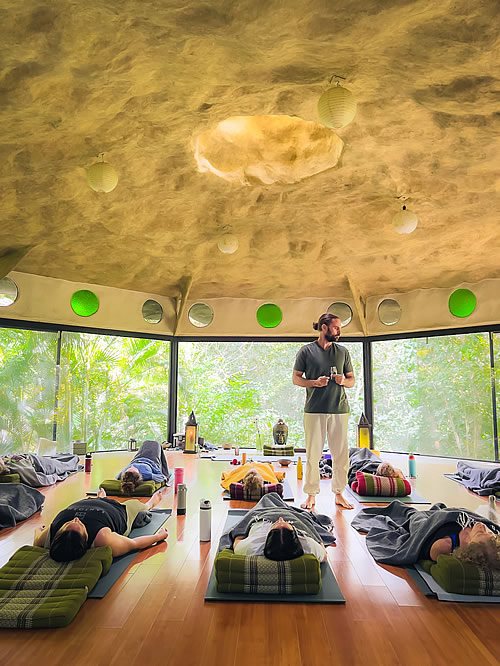The Power of Breath: Integrating Breathwork and Pranayama Into Your Daily Life
The Power of Breath: Integrating Breathwork and Pranayama Into Your Daily Life
In the rush of our modern lives, we often overlook the most powerful tool we carry with us everywhere: our breath. Ancient wisdom traditions have long recognized what science now confirms—conscious breathing has profound effects on our physical health, mental clarity, and emotional well-being. Just a few minutes of intentional breathwork can transform your day, shifting you from stressed to centered with remarkable speed.

The Science Behind the Breath
Each breath you take influences your autonomic nervous system, toggling between your sympathetic (fight-or-flight) and parasympathetic (rest-and-digest) responses. When you’re stressed, your breathing becomes shallow and rapid. By consciously slowing and deepening your breath, you can activate your parasympathetic nervous system, lowering heart rate, reducing blood pressure, and releasing tension throughout your body.
Research has shown that regular breathwork practice can:
- Reduce anxiety and stress levels
- Improve sleep quality
- Enhance focus and cognitive function
- Boost immune system function
- Increase energy levels
- Regulate emotional responses

Pranayama: The Ancient Science of Breath Control
Pranayama, from the Sanskrit words "prana" (life force) and "ayama" (control or extension), is the yogic practice of breath regulation. These techniques, developed over thousands of years, offer a systematic approach to harnessing the power of your breath.
Simple Techniques to Transform Your Day
1. Box Breathing (Sama Vritti)
This technique is favored by elite athletes, military personnel, and executives for its calming effects:
- Inhale for a count of 4
- Hold for a count of 4
- Exhale for a count of 4
- Hold for a count of 4
- Repeat for 5-10 cycles
Perfect for: Before important meetings, during stressful situations, or to clear your mind before making decisions.
2. Alternate Nostril Breathing (Nadi Shodhana)
This balancing practice helps harmonize the left and right hemispheres of your brain:
- Close your right nostril with your right thumb and inhale through your left nostril
- Close your left nostril with your ring finger, release your thumb, and exhale through your right nostril
- Inhale through your right nostril
- Close your right nostril, release your ring finger, and exhale through your left nostril
- Repeat for 5-10 cycles
Perfect for: Transitioning between activities, preparing for meditation, or calming an overactive mind.
3. 4-7-8 Breathing
Developed by Dr. Andrew Weil, this technique acts as a natural tranquilizer for the nervous system:
- Inhale quietly through your nose for a count of 4
- Hold your breath for a count of 7
- Exhale completely through your mouth for a count of 8
- Repeat for 4 cycles
Perfect for: Falling asleep, managing acute stress or anxiety, or calming anger.

Integrating Breathwork Into Your Daily Routine
Morning Ritual (2-5 minutes)
Start your day with 10 deep belly breaths before reaching for your phone. This sets a mindful tone and activates your parasympathetic nervous system before engaging with external stimuli.
Transition Moments (1 minute)
Between meetings or tasks, take 5-10 conscious breaths to reset. This creates a clean mental slate and prevents stress accumulation throughout the day.
Commute Practice (5-10 minutes)
Transform your commute into a breathing sanctuary. Whether on public transport or waiting in traffic, use this otherwise "lost" time for breathwork.
Pre-Meal Centering (30 seconds)
Take three deep breaths before eating to activate your digestive system and bring mindfulness to your meals.
Bedtime Wind-Down (3-5 minutes)
Practice 4-7-8 breathing as you lie in bed to signal to your body that it’s time to rest and restore.
The Two-Minute Breakthrough
When you’re feeling overwhelmed, remember that you’re just two minutes away from a different state of mind. Try this emergency reset:
- Find a quiet place (even a bathroom stall will do in a pinch)
- Place one hand on your chest and one on your belly
- Take a deep breath through your nose, filling your belly first, then your chest
- Hold briefly at the top
- Exhale slowly through your mouth, making a gentle whooshing sound
- Repeat for 2 minutes (about 12-14 breaths)
This simple practice can interrupt the stress response, clear cortisol from your system, and restore cognitive function when you need it most.

Building a Sustainable Practice
The key to making breathwork a lifestyle rather than just another item on your to-do list is integration rather than segregation. Instead of seeing it as something else you need to make time for, attach it to existing habits:
- With your morning coffee or tea
- During your shower
- While waiting for your computer to boot up
- Before important phone calls
- As you wait for the elevator
- During commercial breaks
By creating these "breath anchors" throughout your day, you’ll naturally build a practice that supports you without requiring significant time commitments.
The Ripple Effect
As you develop this relationship with your breath, you’ll notice subtle shifts extending beyond the moments of practice. Many practitioners report:
- Greater emotional resilience
- Improved relationships as they respond rather than react
- Enhanced intuition and decision-making
- A deeper sense of connection to themselves and others
- More frequent experiences of flow states
Getting Started
Remember that consistency trumps duration. Three minutes of daily practice will yield more benefits than an hour-long session once a week. Start where you are, with what you have, and build gradually.
Your breath is always with you—a portable, powerful tool for transformation that requires no special equipment, location, or preparation. In just a couple of conscious breaths, you can shift your biochemistry, change your mental state, and open to a different way of being in the world.
The journey of a thousand miles begins with a single step—or in this case, a single breath.









Comments